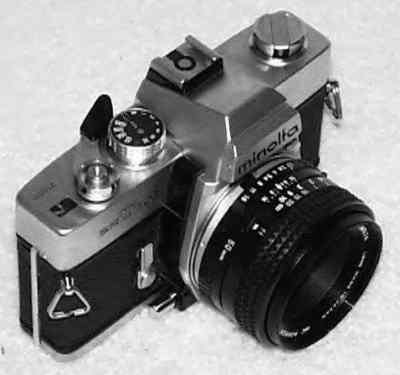
SRT202
(1975) In 1975, Minolta "upgraded" the original SRT100 series to the SRT200
series. Actually, there was very little difference between the two
series of cameras. Perhaps Minolta felt that the SRT100 series name
was getting too old and that the public wanted something "new". After
all, the early 1970's saw dramatic competition in the camera market, and
other camera companies were producing "new" cameras with new names -- some
with very minor changes. For example, Nikon added a hot shoe to it's
Nikkormat FTN in 1975, and called it the Nikkormat FT2. In the same
vein, Minolta made some minor changes to all of the Minolta SRT100 series
cameras -- and the SRT200 series was born.
The SRT202 was a modified version of the SRT102.
The problem was that since the SRT102 was
such a perfect camera, how could you update or improve it? All Minolta
could do was add a couple of convenience features. Unfortunately,
they removed some at the same time. One step forward, one step back. There
were actually several versions of the SRT202, depending on the market, with
slight variations over time. The model numbers are not inscribed on
the cameras.
-
SRT202 (model a) -- (1975)

The first model of the SRT202 was almost the same as its predecessor, the
SRT102 (model b), but it had the addition of a film
tab holder on the back (the new film memo holder retains the ASA/DIN
converter, but you can't see it if you have a film tab inserted) and a film
advance window. Nice touches, but Minolta dropped the mirror lock-up
feature. Two steps forward, one step back. The viewfinder and focusing screen
remained the same:
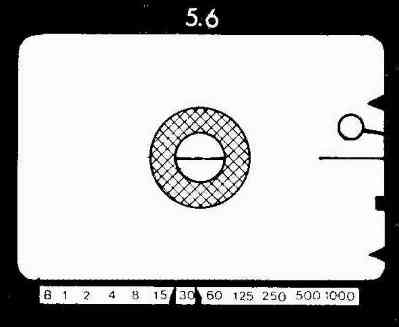
But there were sublte differences as well. The previous model had "MINOLTA
CAMERA CO.,LTD." imprinted on the top between the pentaprism and the rewind
crank. On this model, the imprint is gone. In addition, the film plane indicator,
which had been behind the shutter speed dial (on the right), is now placed
between the pentaprism and the rewind crank (on the left). This was a smart
move and makes measurements a little easier for those few people who use
it. Last, the hot shot on this model is marked with a red "X", hopefully
to remind users that the "hot" part of the shoe is only usable with X-synch,
not bulbs. The SRT202 (model a) was available in black or chrome.
-
SR505 -- (1975)
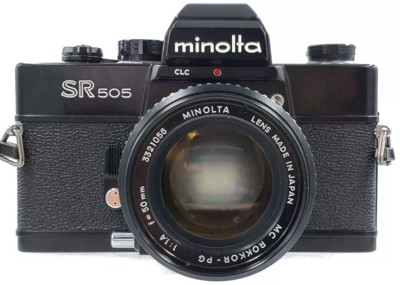
Japanese version of the SRT202 (model a).
-
SRT303b (model a) -- (1975)
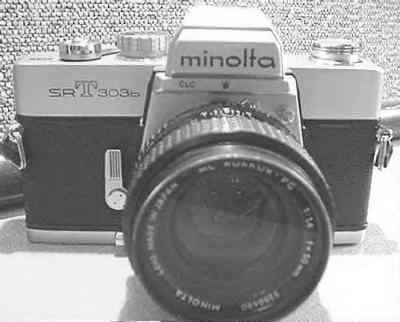
European version of the SRT202 (model a).
-
SRT202 (model b) -- (1977)
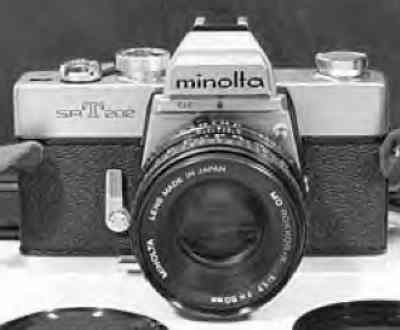
In 1977, a few changes were made to the SRT202 (model a). This was
the same year that Minolta introduced the first of the XD and XG cameras,
and several of these features were copied directly from the XD and XG line.
Perhaps it was an attempt to make the older-styled cameras look as
similar as possible to the newer cameras, but it is just as likely that the
newer parts were available -- and useable -- on the older cameras. First,
there was a switch on the SRT202 (model b) to a black, plastic aperture ring
around the lens mount -- replacing an aluminum ring.
In addition, the locking DOF button of the earlier SRT cameras was replaced
with a non-locking DOF button. On the surface, this sounds like a minor cosmetic
change. But the change is more than skin deep. At the same time, Minolta
dropped the "meter off" switch which, in all previous SRT models, would
automatically turn the meter off when the DOF button was pressed (when an
MC lens was attached to the camera). The purpose of this early feature
was to allow metering in "stop-down" mode with early non-MC lenses. That's
why the DOF button on Minolta SLR cameras was originally called the
"stop-down-metering" button. So with this switch, Minolta was cutting out
a few cents in manufacturing costs -- and casting aside users of earlier
lenses.
Also, the SRT202 (model b) only had X synchronization for flash use -- the
FP option of the SRT202 (model a) was dropped. The SRT202 (model b)
was available in black or chrome. Look for the black, plastic aperture
ring around the lens mount to identify the SRT202 (model b).
-
SR505s -- (1977)

Japanese version of the SRT202 (model b).
-
SRT303b (model b) -- (1977)

European version of the SRT202 (model b).
Sad to say, in 1978, Minolta dropped the SRT202 from it's line of cameras.
The SRT202 was it's most expensive manual-exposure camera, and they
felt that most people who would spend that much money would want the added
features of an automatic-exposure camera, like the
XD-11 and XG-7. In addition,
they had just upgraded the SRT201, so that there
were few advantages in the SRT202.
Since the shutter will operate without a battery, it is built like a tank,
has complete viewfinder information, and many other features, many consider
the SRT202 to be the best manual-exposure camera ever made -- by any
manufacturer! It's only competition is the
SRT102. Which should you choose? For a comparative
look at the major features of the SRT202 models, check out
MINMAN's SLR table
-- the world's most complete!
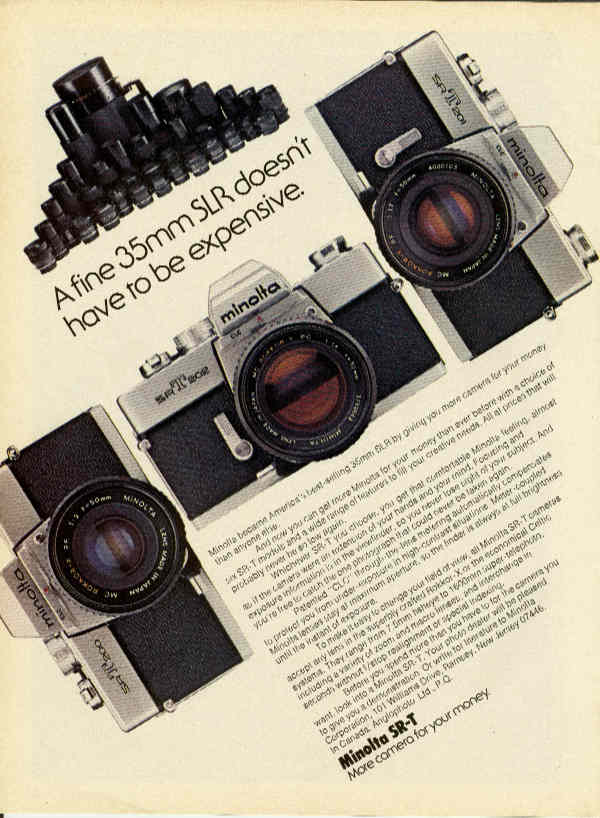
RETURN TO THE MANUAL
MINOLTA HOME PAGE We didin't want to do this, but since other websites
have been stealing our stuff, we have no alternative but to state:
COPYRIGHT@1995-2023 by
Joe McGloin.
All Rights Reserved. The material on this website is protected by US Federal
copyright laws. It cannot be copied or used in any manner without specific
approval from the owner.
The material on this website is protected by US Federal copyright laws. It
cannot be copied or used in any manner without specific approval from the
owner.









